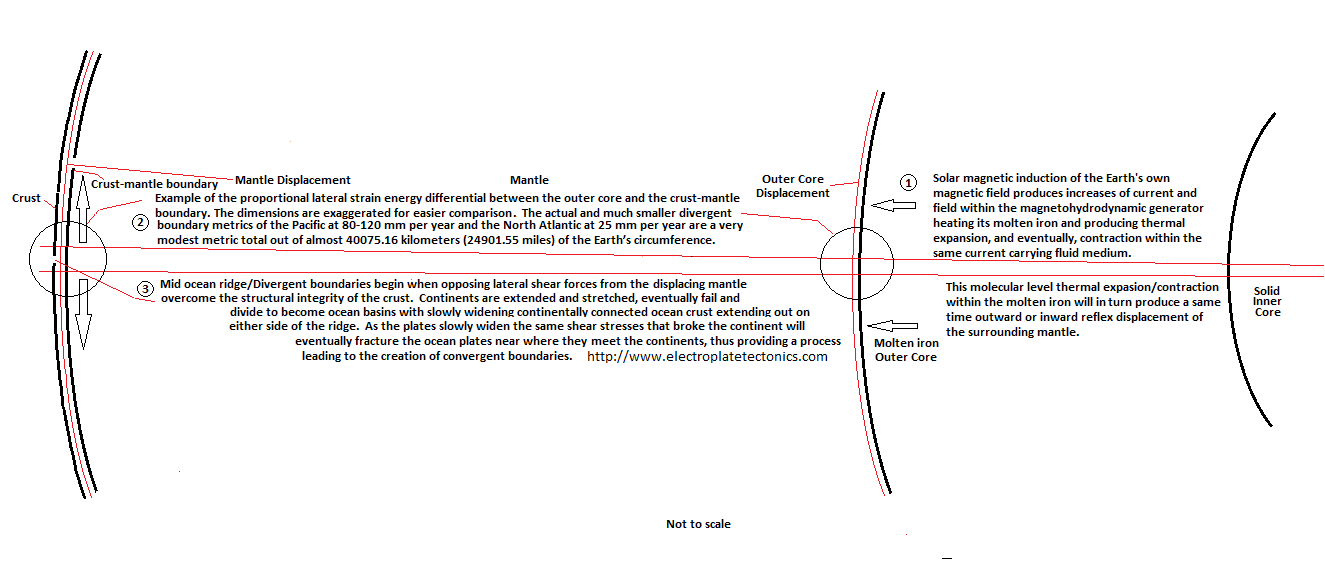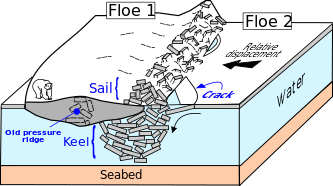-
Posts
978 -
Joined
-
Last visited
Content Type
Profiles
Forums
Events
Everything posted by arc
-
I really could have lived the rest of my life without seeing that!
-

Why this seems to be happening in wild animals'
arc replied to Moontanman's topic in Ecology and the Environment
For it to be driven by natural selection it has to provide an advantage of some sort. Inbreeding because of less genetic variation in a wild population would still require it to have some positive feedback in the first place to concentrate the trait within the select group to make it available. Are you suggesting a new unknown mechanism hidden within the genetic protocol that responds to environmental stresses, producing these anomalies. -
If that can be considered plate tectonics then what would you call drift ice, pack ice and its many related structures such as pressure ridges? http://en.wikipedia.org/wiki/Pressure_ridge_(ice) Image by Lusilier and provided through Wikimedia Commons. The blocks making up pressure ridges are mostly from the thinner ice floe involved in the interaction, but it can also include pieces from the other floe if it is not too thick. In the summer, the ridge can undergo a significant amount of weathering, which turns it into a smooth hill. http://en.wikipedia.org/wiki/Sea_ice Image by Lusilier and provided through Wikimedia Commons. Though they share similar terminology and maybe even some of the same mechanics they are vastly more different than the same. I for one would want plate tectonics to refer to processes that result in the many surface and subsurface structures like mountains, basins, valleys and extensional features like the Basin and Range area. And also the very many types of materials that result from those processes, tectonics on earth are a veritable factory where all of the terrestrial building materials are made or processed. That ice on Europa seems rather two dimensional, rather uniform when compared to what terrestrial tectonics can deliver in terms of grandeur. Its just ice after all.
-
-
I think he's alluding to the N word maybe.
-
Counterfeit drugs are often detected first by the poorly done instructions.
-
I find it difficult to disconnect the Renaissance from all that followed its supposed end in the 17 century. Did not its influence in science continue uninterrupted into the industrial revolution and the concurrent discoveries of what formed the foundations of modern chemistry and physics throughout the 18th and 19th centuries? Are we possibly in the second half or now moving into the third period? Someday, 800 or 1000 years from now, those looking back may view these last 500 years as a continuous period of cultural evolution. Science - Copernicus, Galileo, Newton, Einstein and ? Media/mechanical - Printing, clock making, machinery, computers, internet. Medicine/anatomy - Andreas Vesalius' studies, William Harvey, Henry Grey, X-ray, MRI, CT scan. microbiology - Girolamo Fracastoro, Antonie Philips van Leeuwenhoek, Ferdinand Julius Cohn, Martinus Willem Beijerinck, Sergei Nikolaievich Winogradsky. Da Vinci can be in several of these. The American experiment, started in the late 18th century and continuing to the present, is itself the culmination of the ideals born in the Renaissance. In the not too distant future this may be viewed as one continuous period of creative human endeavour.
-
My sincere apologies for breaking the forum rules in this matter but I have seen the impact these people have on the families and more importantly the children of the victims of this tragedy. They can't even visit the site without risk of seeing or hearing these individuals. They are cruel to these families in the most stupid and misguided way.
-
Aemilius; Insulting paragraph removed Airliners can't stay in the air when they sustain catastrophic structural failure and neither can a building. Bridges have a history of collapsing, even without a preceding event initiating the failure. Here is a list of bridge failures. Knock yourself out. http://en.wikipedia.org/wiki/List_of_bridge_failures You could turn every one of them into a conspiracy, and sadly someone like you surely did after each tragedy.
-
I would venture to guess that the bear has had little social interaction besides this crow. This crow has been hanging around for possibly enough time (maybe years) to form a bond. The bear is probably little involved with the endless human spectators, do not feed the bear and what not has left this animal isolated in its little island of cement. The bears "attachment" to the crow is psychological, it is based on the loneliness of its existence. The bears motive could be either empathetic or selfish. I would say a little of both. A female would do the same for her cub, this would not be too far removed from that response.
-
. . . we end up where we started.
-
You might find this paper interesting, It is regarding Mars and what water may have been available in its basaltic rock deep within its interior. http://seismo.berkeley.edu/~manga/phillips2001.pdf Ancient Geodynamics and Global-Scale Hydrology on Mars Roger J. Phillips,1 Maria T. Zuber, 2, 3 Sean C. Solomon, 4 Matthew P. Golombek,5 Bruce M. Jakosky 6 W. Bruce Banerdt, 5 David E. Smith,3 Rebecca M. E. Williams, 1 Brian M. Hynek, 1 Oded Aharonson, 2 Steven A. Hauck II, 1 1 McDonnell Center for the Space Sciences and Department of Earth and Planetary Sciences, Washington University, St. Louis, MO 63130, USA. 2 Department of Earth, Atmospheric, and Planetary Sciences, Massachusetts Institute of Technology, Cambridge, MA 02139, USA. 3 Earth Sciences Directorate, NASA/Goddard Space Flight Center, Greenbelt, MD 20771, USA. 4 Department of Terrestrial Magnetism, Carnegie Institution of Washington, Washington, DC 20015, USA. 5 Jet Propulsion Laboratory, California Institute of Technology, Pasadena, CA 91109, USA. 6 Laboratory for Atmospheric and Space Physics, University of Colorado, Boulder, CO 80309, USA. The release of CO2 and H2O to the martian atmosphere from magma erupted and intruded during Tharsis formation may have affected the Noachian climate. For the 100-km-thick elastic lithosphere we assume (2), the observed topography plus the volume of material contained within the depression resulting from Tharsis loading amounts to ~ 3 x 10^8 km^3 of igneous material, which is equivalent to a 2-km-thick global layer (30). For a magmatic CO2 content of 0.65 weight percent (wt %) [which is consistent with Hawaiian basaltic lavas (31)] and an H2O content of 2 wt % (32), the total release of gases from Tharsis magmas could produce the integrated equivalent of a 1.5-bar CO2 atmosphere and a 120-m-thick global layer of water. These quantities of volatiles are sufficient to warm the atmosphere to the point at which liquid water is stable at the surface (33). The accumulation of atmospheric CO2 may have made the latter part of the Noachian the most favorable time for this condition.
-
I find it rather interesting that a certain mindset that sees this footage as authentic will undoubtedly in turn claim that legitimate documentation of events such as the NASA Apollo moon landings are fake. There is a predictable pattern of behavior of those involved in so much of this pseudo/scientific genre. Edit, needed some improvement.
-
My apprenticeship into the "dark language arts" began one summer when these new kids moved into the neighborhood three houses up the street from ours. I had never seen or met people like this before. This was around 1970, I was maybe 7 or 8 and the only thing my dad ever let loose was a loud DAMMIT when he lost his cool. This new kid Roger wanted to fight at the drop of a hat, cussed like a biker and smoked his mom's cigarettes. I don't know where they came from but she cut Rodger and his little brother's crew cuts herself. His little brother was in the second grade and would stand there smoking a Winston while casually conversing in four lettered conversation, it was exhilarating for the rest of us, we had never heard such banter. They didn't have a dad as far as we knew and even more shocking to our little sheltered corner of the world was that their mom wore her hair just short of a crew cut. She looked like the toughest gal you had ever seen, sun weathered like an old catcher's mitt, she'd go out on the front porch and let go a four letter tirade at her kids or worse yet one of us, we were terrified. The real shocker came when school started up, she was one of the bus drivers!
-
I've always felt that Ralphie from the movie "A Christmas Story" summed it up nicely; "Now , I had heard that word at least ten times a day from my old man. My father worked in profanity the way other artists might work in oils or clay. It was his true medium." "Over the years I got to be quite a connoisseur of soap. My personal preference was for Lux, but I found Palmolive had a nice, piquant, after-dinner flavor, heady but with just a touch of mellow smoothness."
-
#$%& NO!
-

Can (New) Physics Exist Without Mathematics?
arc replied to Nicholas Kang's topic in General Philosophy
At some long ago forgotten time, that was surely repeated many times but never remembered or recorded, a sunrise was observed. Was that the physics you refer to? Or was it when a stone was placed to mark the point where the observer would stand and another where the Sun had risen. Was that then the act of physics? Or was it when they observed that the stones they had placed to mark the consecutive points of sunrise were evenly spaced, and by that observation - measured? -
“Writing is easy. All you have to do is cross out the wrong words.” Mark Twain
-
http://en.wikipedia.org/wiki/Whale All cetaceans, including whales, dolphins and porpoises, are descendants of land-dwelling mammals of the Artiodactyl order (even-toed ungulates). Both are related to the Indohyus, an extinct semi-aquatic deer-like ungulate, from which they split around 54 million years ago. These primitive cetaceans first took to the sea about 50 million years ago and became fully aquatic about 5–10 million years later. Their features became adapted for living in the marine environment. Major anatomical changes include streamlining of the body, the migration of the nasal openings towards the top of the cranium, the shrinking and eventual disappearance of the hind limbs, the modification of the forelimbs into flippers, and the growth of flukes on the tail. A deer-like ungulate eventually became; "the blue whale, the largest animal known to have ever existed at 30 m (98 ft) and 180 tonnes (180 long tons; 200 short tons)" This 50 million year transformation began from very small indistinguishable changes in a small group of "land-dwelling mammals of the Artiodactyl order". It may have been similar to the hippos own slow adaptation to water that slowly over generations saw that they both increased their ability to hold their breath underwater. Uncountable environmental influences steered this course like a single grain of sand in a sand storm. A specific plant that adapted to a particular water habitat may have been crucial to these ancestors of whales, and a fish that ate the snail that threatened the plant may have been threatened itself by parasites. And any of these themselves were dependent of cascades of unknowable input. These causes and effects spread out into the preceding history of all these species and all others in history, a random number generator could not be any better at this.
-
Is there a purpose to random events? Adding or subtracting miniscule influences of flora, fauna and climate will change long range outcomes substantially. Purpose imposed onto evolution would suggest a predictive aspect. Would you care to imagine calculating where every grain of sand in a given sand storm will end up in a half a million years?
-
Well, we can only speculate. But billions of years? http://en.wikipedia.org/wiki/Sahara#History The climate of the Sahara has undergone enormous variations between wet and dry over the last few hundred thousand years.[30] This is due to a 41,000 year cycle in which the tilt of the earth changes between 22° and 24.5°.[31] At present (2000 CE), the Sahara is in a dry period, but it is expected that the Sahara will become green again in 15,000 years (17,000 CE). I suggested climate due to what I believe are more opportunities that the termites in the affected area would be subjected to a forcing mechanism, a gradually drying environment would affect a much larger sample of the species to natural selection. Not necessarily in the Sahara, but a climate induced stress in a geographic area somewhere of a comparable size and scale. A gradual climate transition that would give the species the time needed to adapt to a dryer environment. This adaptation allowed this new hardier termite to move from damp environments in soils and older decomposing downed timber to dryer sources of food and the advantages of living where you work. I think its more difficult to tie predation to this very substantial change, not that it couldn't happen that way, but a much larger selection exposed to the climate forcing increases the odds that adaptable traits are being passed in greater quantities within the affected group. Predation often produces defensive adaptations like stingers and bitter or smelly excretions. There has to be a substantial period of time that the conditions do not change to allow the gradual adaptations to amount to a substantial end result. Predators come and go. Ants started out 110-120 million years ago, termites are even older. I doubt anteaters are the first to discover that ants and termites are tasty.
-
http://en.wikipedia.org/wiki/Termite Termites are a group of eusocial insects that, until recently, were classified at the taxonomic rank of order Isoptera (see taxonomy below), but are now accepted as the infraorder Isoptera, of the cockroach order Blattodea. While termites are commonly known, especially in Australia, as "white ants," they are not closely related to the ants. So even though they are not closely related and its not a very good example lets imagine why an animal like a drywood termite might be a logical outcome of its environment. We currently have wood boring ants such as carpenter ants that don't actually eat the wood, they have just evolved to nest in it, and it could have been due to some predator that easily dug up any buried nests. So a stronger wooden home in a log gave them an edge over the subterranean ants and those predators that had not developed an answer to getting into those tree trunks. There is also a subterranean ant called a leaf cutter ant, they grow a fungus to eat in their nest, cultivated on the plant leaves that they had gathered. Both these species developed or changed to provide a particular solution to the challenges that their individual environments threw at them. But they both have a similar vulnerability, they must leave their nests to either gather their leaves to grow the fungus, or in the carpenter ants case, to gather insects to feed their colony. Termites have similar wood boring and even fungi culturing varieties like the ants, but their bodies are more fragile and the need to retain moisture is critical, so they must stay underground or build tunnels to move from the nest to their food. The drywood termite has evolved to stay and live in its food source and to not need the moist subterranean nests or tunnels. It seems logical then that the (drywood) termites ancestors that could utilize the wood for not only food but also shelter would gain some advantage, and could avoid the predators that still preyed on the other dampwood and subterranean varieties that are more vulnerable to the claws and even long tongues of predators. But these changes that seem to us as logical and some would even suggest hint at an almost determinant motivation on the part of the termite are in actuality the likely result of that particular environment slowly becoming drier and forcing the selecting of a new species. edit spelling.
-
Well, I believe our ancestors first scientific endeavour in "Biochemistry" lead to the formation of the first civilisations. http://en.wikipedia.org/wiki/History_of_beer Chemical tests of ancient pottery jars reveal that beer was produced about 7,000 years ago in what is today Iran, and is one of the first-known biological engineering tasks to utilize the process of fermentation. In Mesopotamia, the oldest evidence of beer is believed to be a 6,000-year-old Sumerian tablet depicting people drinking a beverage through reed straws from a communal bowl. A 3900-year-old Sumerian poem honouring Ninkasi, the patron goddess of brewing, contains the oldest surviving beer recipe, describing the production of beer from barley via bread. And the rest, as they say, is (our) history. (hic)






